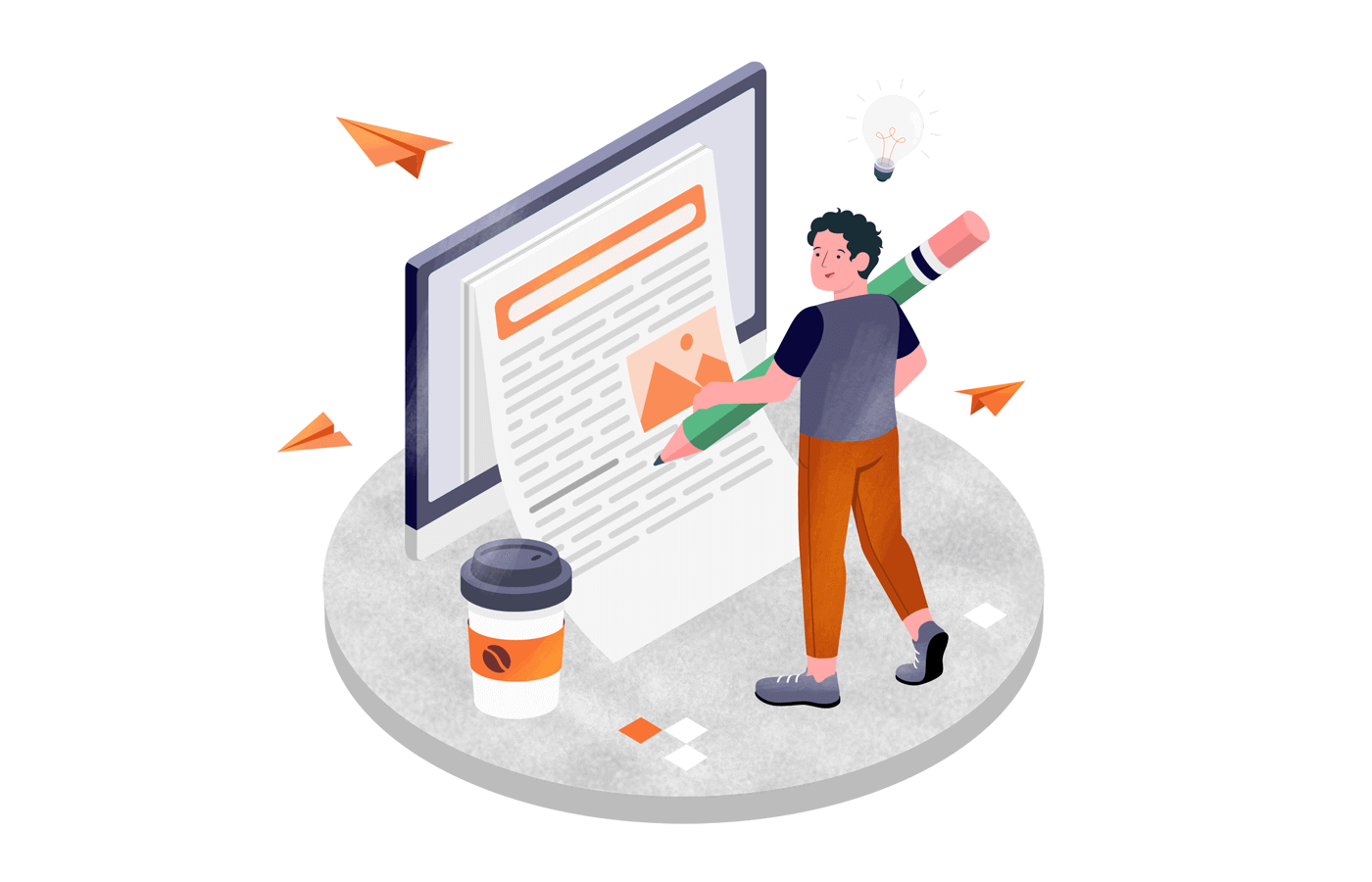Are you looking to build an email newsletter campaign that gets real engagement? Building an email newsletter campaign that engages readers requires effort.
With the average person reading only a few newsletters from the hundreds of websites they have subscribed to, it’s essential to stand out from the competition.
As prospects show interest in your business by signing up to join your email list, it also presents an excellent opportunity to capture their attention and build a relationship.
That’s why in this blog post, we’ll share 12 tips for creating compelling newsletter content, along with some inspiring examples of the best email newsletters.
What Should Newsletter Article Content Contain?
Newsletter emails are a way to keep your audience updated on all the latest news and releases related to your product or brand. They also allow brands to promote and share their blog posts, interviews, roundups, and other helpful information.
Many businesses typically send newsletter emails on a scheduled basis, whether daily, weekly, or monthly.
Creating daily content for newsletters can be challenging, even for experienced marketers with creative writing skills. Here’s a quick list of ideas:
- Welcome email
- A message from the CEO
- Product or service guides/ updates
- Exclusive offers and discounts
- Testimonials and success stories
- Community and UGC content
- Feedback collection to measure satisfaction
- Gratitude and thank you email
- Company milestone or anniversary
- Resource roundup
- FAQs with answers
These content ideas are just the beginning! The key is to provide value to your business and subscribers with any content you include in your newsletter articles.
Newsletter sending would be a disaster without a great email marketing tool, right?
Good thing you can send captivating newsletters effortlessly and affordably with Sender. Responsive premade templates, simple drag-and-drop email builder, robust automation feature, and much more — absolutely free!
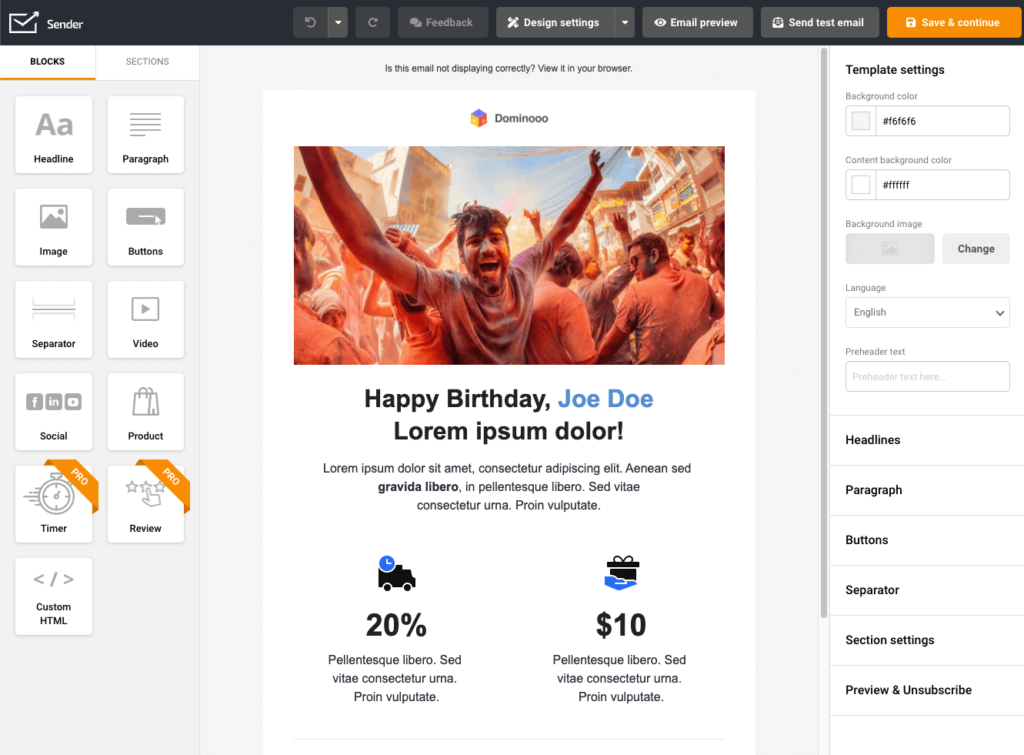
How to Write a Newsletter Content: 12 Actionable Tips
Follow these tips and creating newsletter content will be a childsplay.
1. Be Concise
In email newsletters, less is often more. Your readers are busy and often don’t have time to sift through lengthy content.
So, avoid unnecessary banter and lengthy introductions. Keep your newsletter articles concise and focused on one topic or message.
To ensure your content is easily digestible, be clear and straight to the point in your writing. Be specific, thoughtful, and useful before hitting the send button.
Here’s an example from Apple that illustrates this approach, telling customers they can deliver last-minute gifts in just two hours.
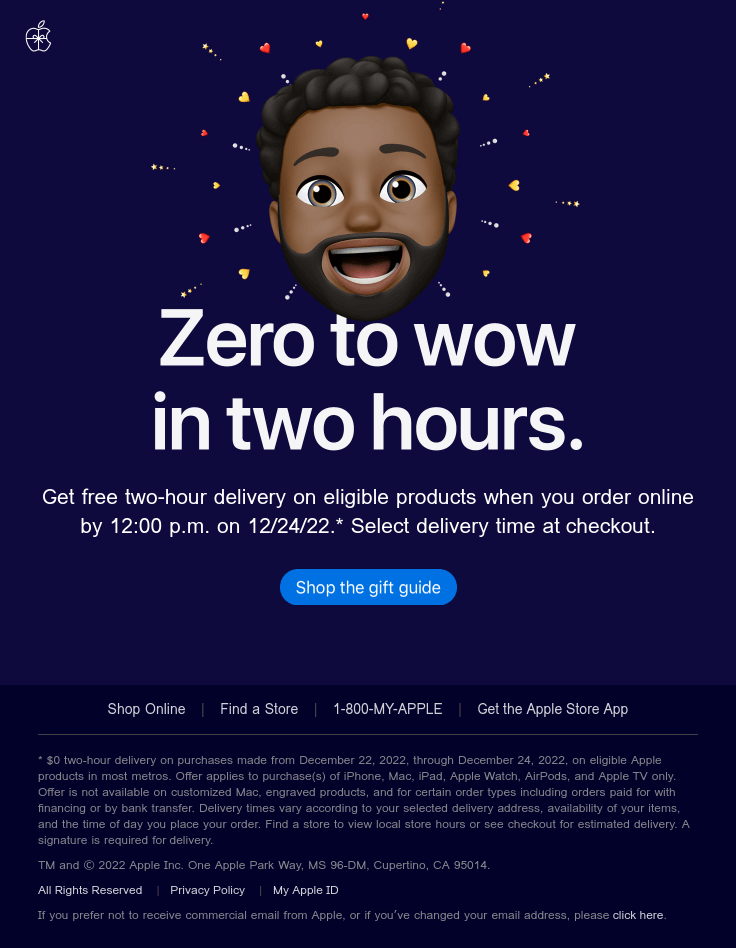
2. Compelling Subject Line
Your email subject line is the first impression your readers have before they decide to open your newsletter article.
Writing a compelling subject line that piques your readers’ curiosity can entice them to click on your email. Here are some quick tips:
- Use action words at the beginning of your subject line to inspire action, such as: “Shop smart on April 1st.”
- Create a sense of urgency by adding a deadline, like “Get 40% off before midnight” or “Limited time offer.”
- Ask a question to pique the subscriber’s curiosity and get them to click on your email to find the answer.
Regardless of your tactic in your subject line, it is crucial to ensure that your newsletter article content delivers on the promise made in the subject line.
Keeping your subject lines compelling and aligned with your content will help increase open rates and engagement with your newsletter.
3. Relevant Content
Another tip for crafting your newsletter campaign is to offer relevant email content.
This means providing valuable data, insights, and solutions that are meaningful and beneficial to your readers. Avoid generic or irrelevant content that may result in unsubscribes.
Relevant content not only attracts and retains your subscribers, but it can also set up an organic process that promotes the sale of your products or services.
Proper segmentation and triggered responses can help you send the right content to the right people at the right time, resulting in a more effective and successful newsletter campaign.
4. Personalize Content
Email newsletters need to be personal. It should be customized to each subscriber, as they have shown a personal interest in your product or business by joining your email list.
Email personalization can be as simple as including your reader’s name in the greeting and content to make it more personal and engaging.
But to truly connect with your readers, it’s essential to segment your email list based on opt-in methods, preferences, behavior, or demographics, so you can deliver relevant content that resonates with each subscriber.
A great example of personalization is Spotify Wrapped, which creates a personalized experience by reminding customers of their memorable moments with Spotify.
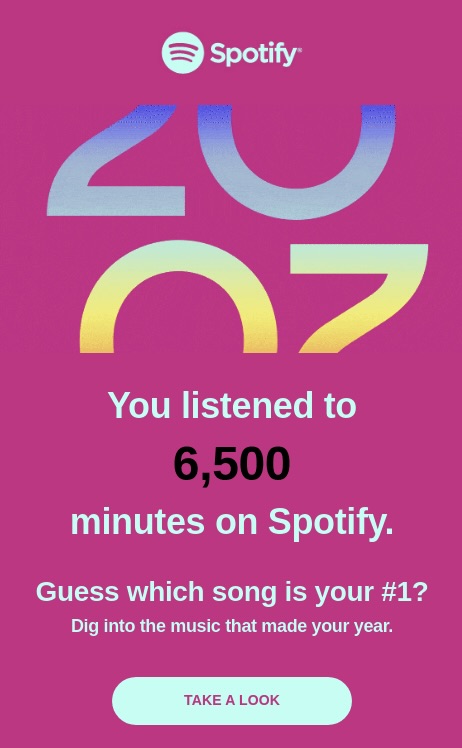
Readers are excited to learn about their listening habits and share them with the world. This has helped Spotfify build stronger relationships with its subscribers and customer loyalty.
5. Catchy Headline
Like your subject line, your newsletter article’s headline should be catchy to grab your reader’s attention. It should evoke emotion or interest to entice your subscribers to continue reading.
A compelling headline sets the tone for your content and can significantly impact the success of your newsletter campaign.
You can use powerful words, statistics, or intriguing statements to make your headline stand out in a crowded inbox.
A great example of this is demonstrated in the email by The School of Life, which starts with the intriguing headline “How to be a fool,” an idea that most people likely never thought of.
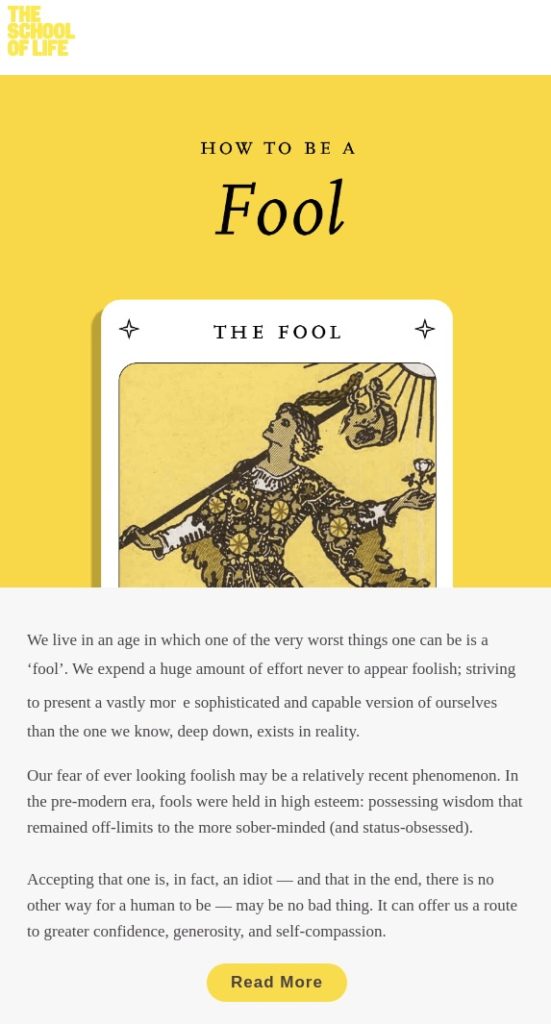
This kind of headline piques curiosity and generates interest, compelling readers to want to know more, and is a powerful technique to make your newsletter stand out and encourage readership.
6. Brief Introduction
Following the headline, the introduction of your newsletter article is a crucial element that determines whether your readers will continue reading.
Keep your introduction brief and captivating, as it serves as a hook to draw your readers in. Clearly state the purpose of your content and highlight the benefits your readers will gain from reading further.
This also sets the tone for the rest of the newsletter. So make sure your introduction creates excitement and anticipation to compel your readers to want to know more.
7. Use Simple Language
When it comes to email copywriting, avoid complex language like technical terms or jargon that may confuse or bore your readers.
Instead, use conversational language to make it easier for your subscribers to understand and resonate with your brand.
Writing in a conversational tone, as if you are speaking directly to your readers, can make your content more engaging and accessible.
An example is the abandonment email from Nomad, which uses a conversational tone to connect with the reader and encourage them to complete their purchase.
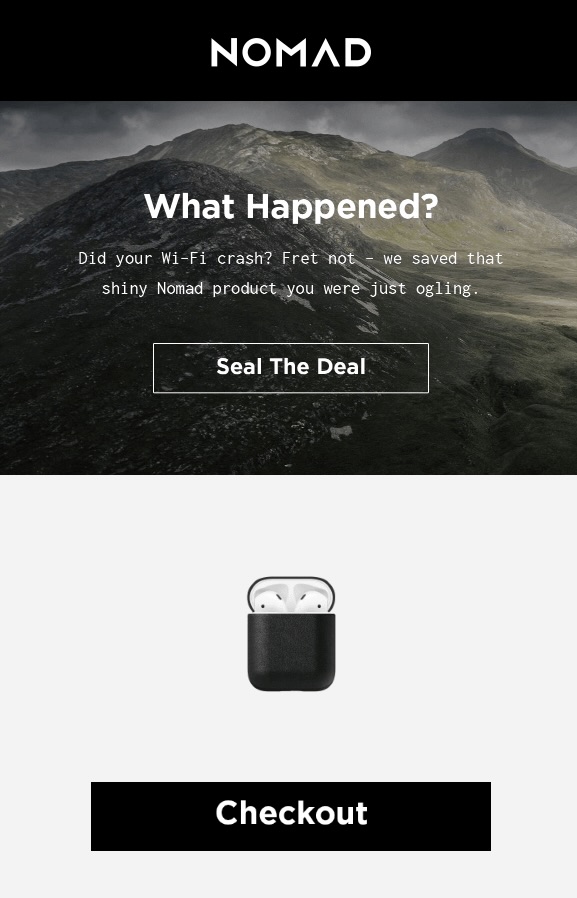
By using simple and relatable language, you can create a more personalized and approachable experience for your subscribers, enhancing their engagement with your content and increasing the effectiveness of your email campaigns.
8. Contextual Links
When including links in your newsletter articles, it’s crucial to use contextual links to drive traffic to your website.
Link to relevant articles, blog posts, or landing pages related to your content.
This not only adds value to your content but also encourages readers to click through and engage further with your brand, enhancing their overall experience.
Avoid using generic link text like “click here.” Instead, use concise and descriptive link text that provides meaning and context to entice readers to click.
Additionally, make sure your contextual links are apparent and easily identifiable, prompting subscribers to instinctually click on them, like this newsletter here by Really Good Emails.
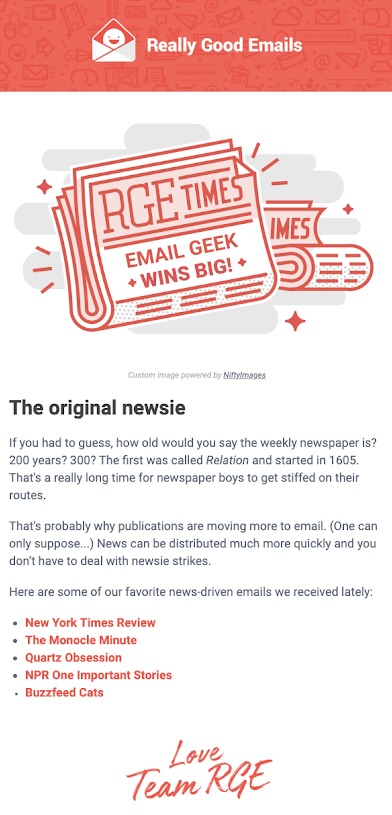
This newsletter by Really Good Emails uses clear and visually appealing contextual links to guide readers to their content.
9. Clear Call-to-Action (CTA)
A compelling call-to-action (CTA) is a crucial element of any effective email, as it prompts your readers to engage with your content, click through to your website, and ultimately take action.
When creating your CTA, keep it short and visually appealing to make it stand out.
Whether it’s to sign up for a webinar, download a resource, or take any desired action, a clear and compelling CTA can significantly improve engagement and conversion rates.
While it’s generally recommended to have one clear CTA, there may be situations where you need to include two or more CTAs.
In such cases, be strategic with your positioning to avoid overwhelming your readers with too many options.
A great example of effective CTA placement can be seen in this email example by Fellow, who cleverly used buttons to segment audiences while presenting it in a visually clean format.
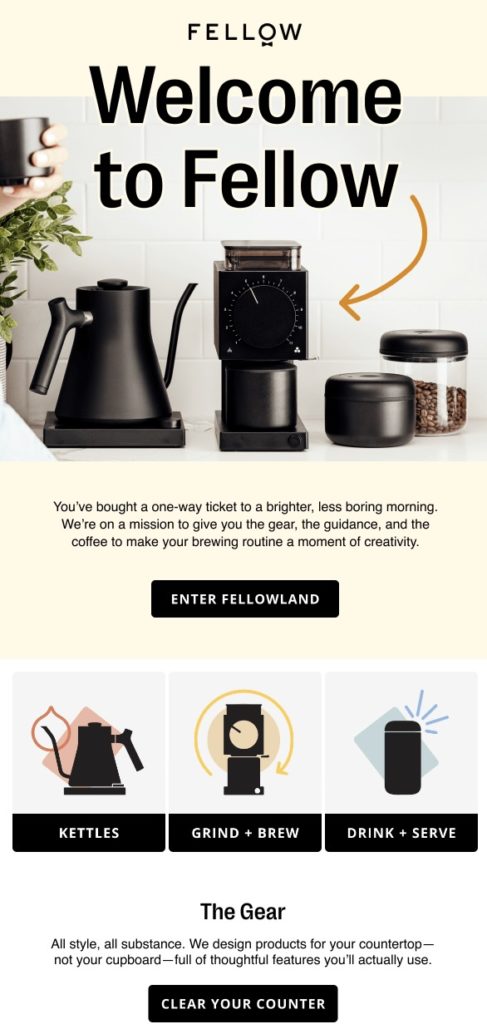
10. Proofread the Article
Nothing can undermine the credibility and professionalism of your newsletter, like grammatical errors, typos, or factual inaccuracies.
Whether you are editing the email yourself or hiring a freelance proofreading service, it’s crucial to thoroughly go through your newsletter content before sending it out to your subscribers.
Pay close attention to spelling, grammar, punctuation, and factual accuracy to ensure your content is error-free and presents your brand in the best possible light.
One tip is to read your content out loud, as this can help you catch any awkward phrasing or errors you may miss when reading silently.
Additionally, consider having someone else review your content with fresh eyes, as they may spot errors you overlooked.
11. Quality Visuals
Quality visuals are not only a great way to present information, but they can also make your content more engaging, memorable, and shareable.
Using high-quality images, graphics, or videos relevant to your content can enhance the visual appeal of your newsletter. Avoid generic stock photos and opt for original visuals whenever possible, as they can help differentiate your content and make it more unique.
An excellent example is the Athletic Greens product email, which effectively uses a product image with benefits to showcase its offering.
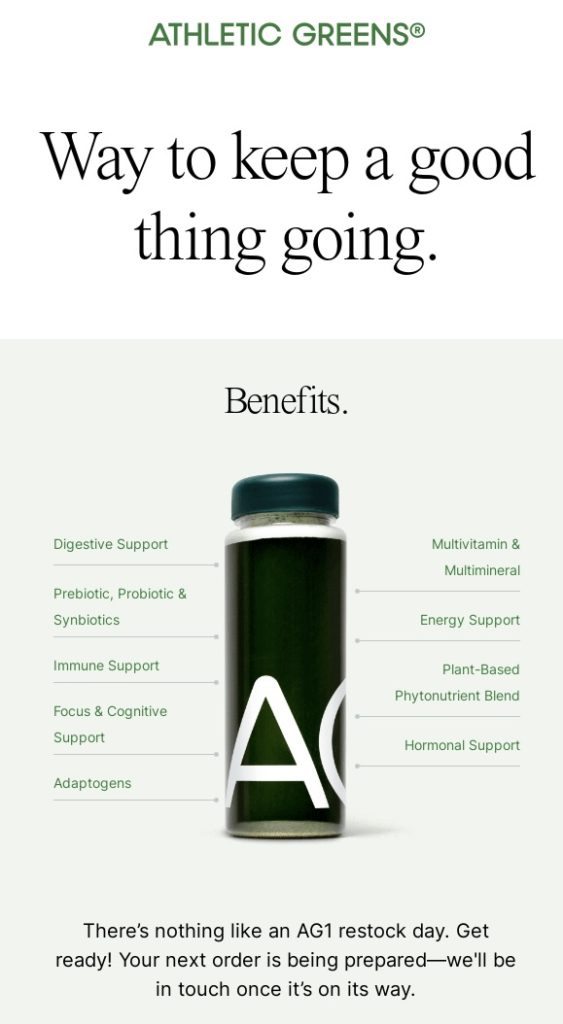
When using visuals in your newsletter, ensure that they are correctly formatted and optimized for email so they load quickly and do not disrupt the overall layout of your content.
Large or improperly formatted visuals can negatively impact your newsletter’s load time and user experience, so optimizing them for optimal performance is crucial.
12. Target Audience
Lastly, always keep your target audience in mind when creating newsletter content. Put a face and name on your audience so you know exactly who you’re talking to.
This makes it easier to craft content that resonates with them but fundamentally understand your target audience’s interests, pain points, and needs and tailor your content accordingly.
When creating targeted email campaigns, you must recognize that you may have multiple types of customers or subscribers. To make these campaigns work effectively, consider creating separate buyer personas for each audience segment.
This allows you to understand the unique characteristics and preferences of each segment better and create content that speaks directly to their interests.
Creating relevant and meaningful content for each target audience can establish a strong connection with your readers and increase engagement.
Conclusion: Best Tips for Creating Newsletter Content
Creating compelling newsletter content requires strategic thinking and attention to detail.
By following these best practices, you can create a newsletter that captivates your readers, fosters a loyal readership, and drives meaningful results for your marketing efforts.
So, take the time to plan, create, and polish your newsletters to ensure they deliver maximum impact and value to your subscribers. Happy newsletter writing!
Author Bio
Adela Belin leads content at Writers Per Hour. With a passion for storytelling, she brings a wealth of knowledge to the field of content marketing and is dedicated to creating result-driven content. Find her on Twitter and LinkedIn.
